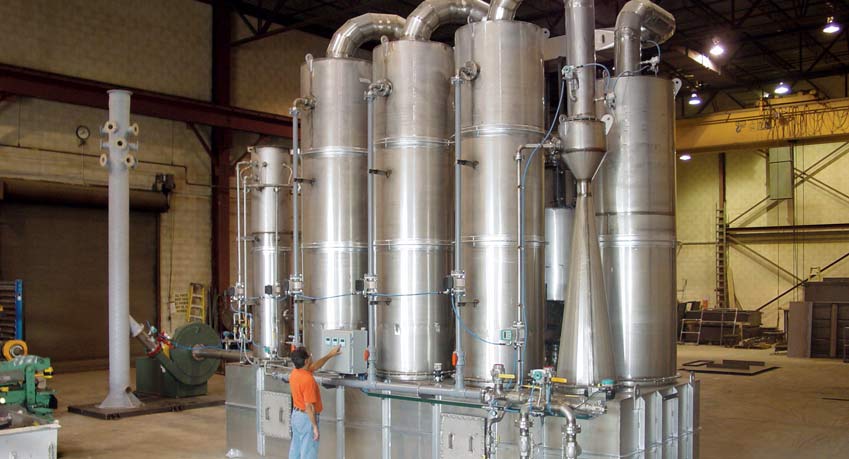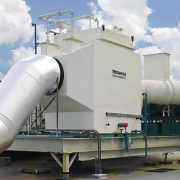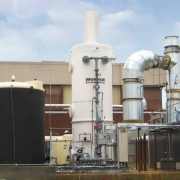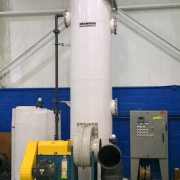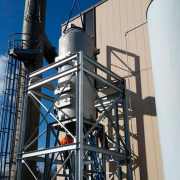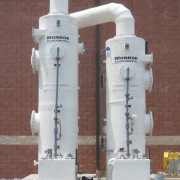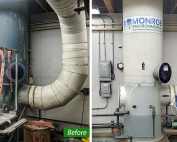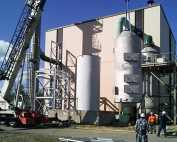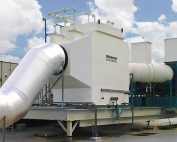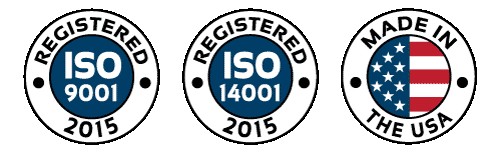Monroe Environmental Packed Bed Scrubbers have been used effectively to remove a wide range of air pollutants in many industrial and municipal applications. We will evaluate your application requirements to determine the optimum design parameters — a custom solution for your plant.
Air Pollution Control Expertise
Monroe Environmental has experience scrubbing many air pollutants in addition to those listed below. Depending on the application other scrubbing liquids for the listed pollutants may be more appropriate. A Monroe Environmental expert will help determine the best solution for your process.
- Acid gas scrubbing — (HBr, HCl, HF, HCN, HNO3, H2S, etc.)
- Halogen vapors (Cl2, F2, Br2)
- Sulfur compounds (Hydrogen sulfide: H2S, Sulfur oxides: SO2, SO3)
- Ammonia (NH3)/amines
- Chromic acids (H2CrO4, H2Cr2O7)
- Ethylene oxide (C2H4O)
- Ethylene glycol (C2H6O2)
- Formaldehyde (CH2O)
- Boron compounds (BCl3, BF3)
- N-Methylpyrrolidone (NMP) (C5H9NO)
- As well as other water or chemically soluble pollutants
Common Scrubbing Liquids
- Sodium hydroxide (NaOH)
- Sodium hypochlorite (NaOCl)
- Potassium hydroxide (KOH)
- Sodium carbonate (Na2CO3)
- Sulfuric acid (H2SO4) and other acids
- Hydrogen peroxide (H2O2)
- H2S scavenger
- And many others
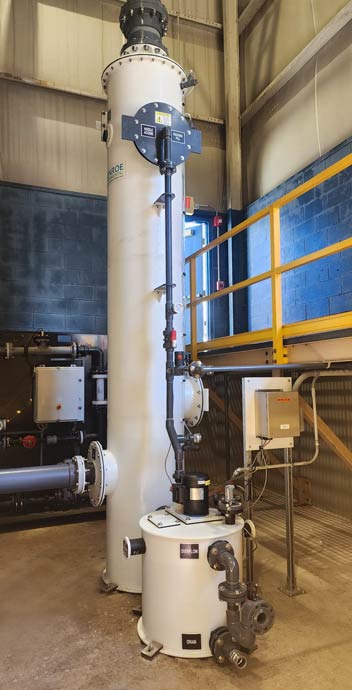
Chemical Addition
- Aqueous solutions of the scrubbing chemical react with the gaseous pollutant to increase absorption of the gas into the liquid.
- In some applications, when solubility is high, water alone may be used as the scrubbing liquid.
- Vapor pressure, solubility, and pH are some of the factors that Monroe Environmental will take into consideration when designing a system to maximize removal efficiency.
Wet Scrubbing Applications
Acid Gas Scrubbing — HCl, H2S, HF, HCN, HBr, etc.
Acid gasses are produced in many industries including battery production, semiconductor manufacturing, the chemical process industry, combustion processes, metallurgical industries, and the glass industry to name a few. Scrubbing with a neutralizing chemical, a base such as NaOH in aqueous solution, produces non-volatile, soluble salts that are removed by the blowdown process.
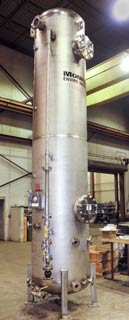
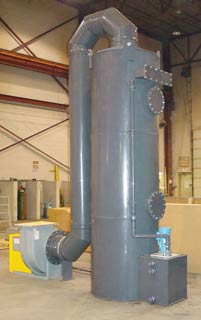
Hydrochloric Acid (HCl)
Hydrochloric Acid (HCl) is a common combustion product of fuels containing the halide chlorine. HCl is scrubbed with NaOH in a Vertical or Horizontal Packed Bed Scrubber according to the reaction:
HCl + NaOH NaCl + H2O
The salt, NaCl, is removed by the blowdown process before it precipitates and contaminates the packing. With sufficient packing height or multiple stages, efficiencies as high as 99.9% can be obtained. Since HCl is highly soluble in water, water alone may provide sufficient absorption of HCl gas in some applications.
Hydrogen Cyanide (HCN)
Hydrogen Cyanide (HCN) is another acid gas example. It is scrubbed with NaOH and sodium hypochlorite (NaOCl). The reactions between scrubbing liquid and acid gas are as follows:
HCN + NaOH NaCN + H2O
Hypochlorite solution: 2NaOH + Cl2 NaOCl + NaCl + H2O
NaCN + (2NaOH + Cl2) NaCNO + 2NaCl + H2O
The salt, sodium cyanate (NaCNO), is less toxic and can be removed by the blowdown process. The pH is monitored by a pH probe. The pH controller runs the scrubbing liquid chemical metering pumps and maintains pH between 9 and 11 to prevent cyanogen chloride (CNCL) or nitrogen trichloride NCl3 formation.
Hydrogen Sulfide (H2S)
Hydrogen Sulfide (H2S) is a common pollutant that must be removed because of its odorous and highly corrosive properties. It is often found at wastewater treatment plants, agricultural facilities, and landfills. It is common to remove H2S from methane (CH4) so that the purified Biogas can be used as a fuel source. Monroe Packed Bed Scrubbers use sodium hydroxide (NaOH) as a scrubbing liquid to remove H2S according to the reaction:
H2S + 2NaOH Na2S + 2H2O
Sulfur Dioxide Scrubbing
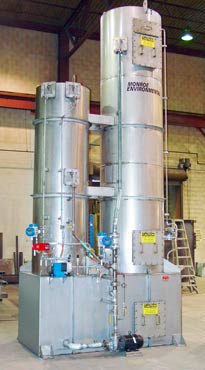
Sulfur dioxide (SO2) is common in flue gasses from many combustion processes. As an example, consider a high temperature gas stream containing SO2 that leaves an incinerator. Typically, Monroe Environmental will provide a Quench Tower in a high temperature application such as this before a vertical counter-flow Packed Bed Scrubber.
The quench tower has spray nozzles that add atomized water to the hot inlet gas stream to saturate it and cool it by evaporative cooling. In a typical example, a temperature drop of the inlet stream from 800°F to (150°F — 165°F) can be achieved by a Monroe Quench Tower. The gas stream then enters the Packed Bed Scrubber. Absorption of the gaseous SO2 by the recirculating NaOH and water scrubbing liquid is much higher at the lower temperature.
The pH is monitored by a probe and typically maintained between 7.5 and 8.5 by the pH controller and chemical metering pump. The basic reaction steps are as follows:
SO2 + H2O SO2H2O
SO2H2O + NaOH NaHSO3 (a salt) + H2O
Na2SO3 + NaOH Na2SO3 (a salt) + H2O (in the presence of excess NaOH)
NaOH neutralizes absorbed SO2, producing a mixture of soluble sodium salts. The carefully chosen packing material provides a large surface area for reaction. The liquid water, SO2 in solution, and salts fall into the tank and are removed. The gas stream then passes through the moisture eliminator pad or chevrons in the top of the packed tower, which removes the remaining water particles from the gas stream before it leaves the scrubber. Removal efficiency greater than 99% can be achieved.
Halogen Vapors (Cl2, F2, Br2)
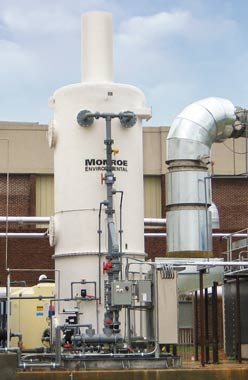
Chlorine Scrubbing:
(note: “X” below can be either Na or K)
Cl2 + 2XOH XCl + XOCl + H2O
(at < 20° C)
3Cl2 + 6XOH 5XCl + XClO3 + 3H2O
(at ≅ 75° C)
The halogen gas is chemically absorbed according to the appropriate reaction, and the resulting product liquids can be removed by a drain or blowdown. Makeup water addition prevents the concentration of salt products from increasing to the point of precipitation.
Scrubbing of NH3 and H2S
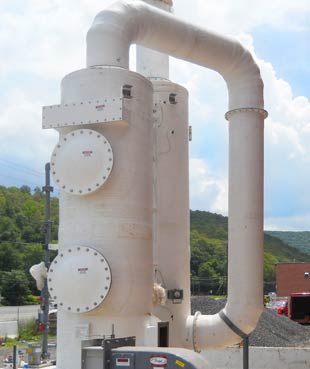
2NH3 + H2SO4 (NH4)2SO4
The salt formed, ammonium sulfate ((NH4)2SO4), is soluble and non-volatile and it is easily removed by the blowdown. The second packed tower uses sodium hydroxide (NaOH) as a scrubbing liquid to remove H2S according to the reaction:
H2S + 2NaOH Na4S + 2H2O
The final stage uses both NaOH and sodium hypochlorite (NaOCl) as scrubbing liquids. NaOCl oxidizes the sulfur-containing compounds producing soluble non-volatile salt compounds according to the overall reaction:
H2S + 4NaOCl + 2NaOH Na2SO4 + 4NaCl + 2H2O
Na2SO4 and NaCl are removed by the blowdown. Overall efficiency for removal of NH3 and SO2 is typically greater than 99% for the process. Depending on which wastewater odors are present and the efficiency required, one or two stages may be all that is needed. In some cases, H2O2 can be used instead of NaOCl as a scrubbing liquid for removing H2S.
Chromic Acid Scrubbing
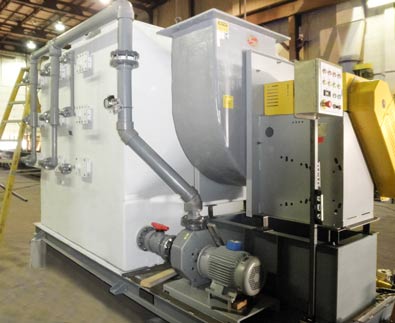
Emissions from chrome plating and chromic acid anodizing operations produce hexavalent chrome mist. This mist cannot be efficiently removed in a conventional Packed Bed Scrubber. Monroe Environmental has developed a modified horizontal or vertical scrubbing unit using multiple specialized mesh filter pads to remove this pollutant.
The pads are rinsed with fresh water and/or recycled water from the scrubber, depending on the application. Often plating chemicals washed off of the pads are returned to the rinse tanks of the plating process.
 Ethylene Oxide (EtO or EO)(C2H4O)
Ethylene Oxide (EtO or EO)(C2H4O)

Sources of ethylene oxide (EtO) emissions include fugitive emissions from EtO production facilities and emissions from plants that use EtO in the production of glycols such as those used in the manufacture of antifreeze and polyester fibers. In addition EtO is commonly used by hospitals to sterilize medical supplies and in the sterilization of cosmetics and spices. EtO is flammable and toxic.
A counter flow Monroe Environmental Packed Bed Scrubber or series of scrubbers can remove EtO at efficiencies greater than 99.9%, depending on the application. The scrubbing solution consists of water and a small amount (usually < 5%) of sulfuric acid (H2SO4). The sulfuric acid catalyzes a hydrolysis reaction:
C2H4O + H2O C2H6O2
The principal product (C2H6O2) is ethylene glycol, which is relatively inert and may be recycled for use as antifreeze. Monroe Environmental will design a scrubbing system that ensures adequate dwell time to achieve reaction completion.
- Semiconductor mfg.
- RTO exhaust HCl, Cl2, & SO2
- HNO3 scrubber system
- SO2 scrubber
- H2S & NH3 scrubbers
Packed Bed Wet Scrubber Applications
Resources & Literature
Recent Case Studies
Air | Extending the Life of an Existing Fume Scrubber
Monroe Environmental is expert in troubleshooting and rebuilding a competitor’s wet scrubbing system to bring it up to like-new efficiency and performance standards.
Air | Packed Tower Wet Scrubber – SO2 Removal
Monroe Packed Tower Wet Scrubber for wastewater treatment plant to absorb and neutralize SO2 from bio-solids incineration exhaust.
Air | Packed Bed Scrubber Solves Toxic Gas Issues
30,000 CFM Horizontal Packed Bed Wet Scrubber System absorbs and neutralizes acid gasses from acid dip tanks.

